Blog

In international trade, containers are essential for the safe and efficient transport of goods globally. Their standardization has revolutionized logistics, allowing products of all kinds to travel by sea, land and air with ease. However, not all containers are the same; there are several types designed specifically for different cargo needs. From standard containers, which are the most commonly used, to specialized containers, such as refrigerated or open top, each serves a specific function to protect and optimize the transport of different products. Knowing the different types of containers and their uses is essential to choose the most suitable one according to the characteristics of the cargo, thus ensuring the integrity of the goods throughout the logistics process.
What is a container?
A container is a large, sturdy metal structure designed to transport goods safely and efficiently across different modes of transport, such as sea, road and rail. Containers are standardized in terms of size and design, which facilitates their handling and transfer between different transport vehicles, such as ships, trucks and trains, without the need to unload and reload cargo.
Types and Uses of Containers
In international trade, containers are essential for the efficient and safe transport of goods. There are several types of containers, each designed to suit different types of cargo and logistical needs. Here are the most common types and their uses:
1. Dry Van Container (DV)
This is the standard container, mainly used for most general goods that do not require special temperature conditions, such as bags, boxes, shrink-wrap packs, machines, furniture, among others. Its storage capacity is 23,000 kg. and has an extension of 20 and 40 feet.
Uses: Transportation of non-perishable products, machinery, clothing, furniture, electronic products, etc.
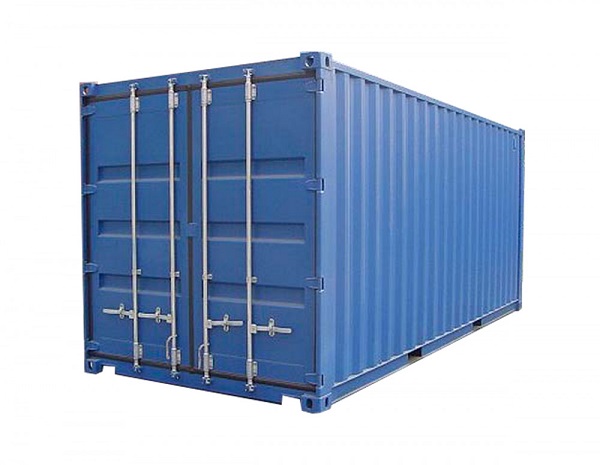
2. Reefer Container
This type of container has a refrigeration system that allows maintaining specific temperatures required for the preservation of perishable products such as meats, fruits and vegetables, but can also be used for electronic parts or films that need a constant temperature.
Uses: Transport of perishable foods, pharmaceuticals, frozen products, fruits and vegetables.
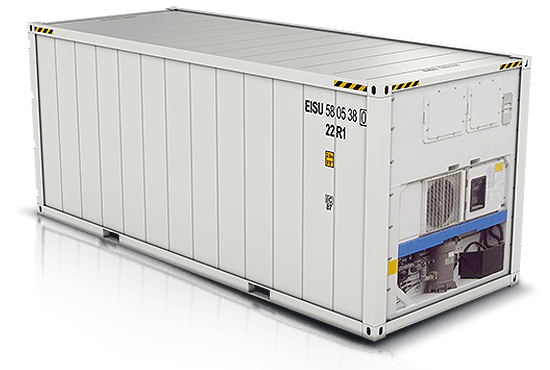
3. Flat Rack Container
Container without sides or roof, which facilitates the loading and unloading of bulky and heavy goods. Also known as folding platforms because they do not have side walls, this type of containers are used for the transportation of heavy vehicles, oversized machinery, among others.
Uses: Transport of vehicles, heavy machinery, pipes, large structures, and other oversized products.
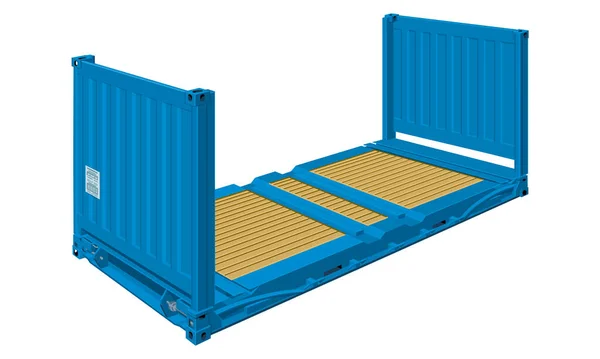
4. Open Top Container (OT)
Container that does not have a fixed roof, which allows loading large goods from above. The roof is covered with a tarpaulin to protect the cargo. Very similar to the Dry Van with measures of 20 and 40 feet, with the difference that it does not have a roof, making it easier to load heavy or bulky goods.
Uses: Transportation of heavy machinery, construction materials, products of great height that do not fit in a standard container.
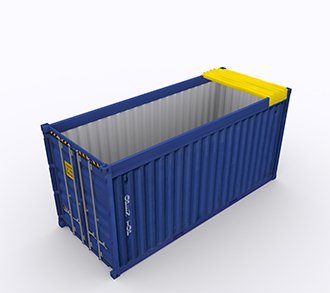
5. Iso Tank Container
These containers are specially designed to transport potable (food), hazardous and non-hazardous liquids, including corrosive, toxic, flammable and explosive liquids. Their structure protects the contents and allows them to be stacked one on top of the other.
Uses: Transport of chemical products, food liquids, fuels and other bulk liquids.
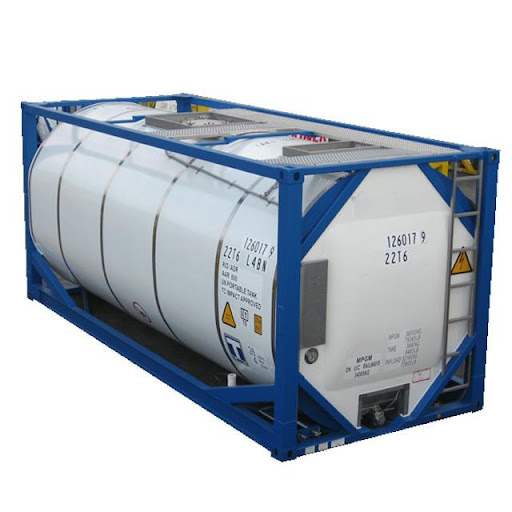
6. High Cube Container (HC)
Similar to the Dry Van container, but with greater height (approximately one foot higher), which provides more space for bulky goods. They are strong, safe and very weather resistant, which makes them very useful in the transport of goods by sea.
Uses: Transportation of light but bulky goods, such as large furniture, light equipment, or textiles.
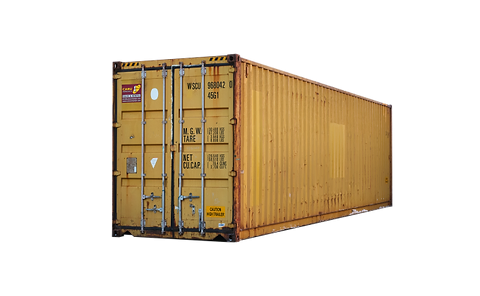
7. Refrigerated High Cube
Used for a multitude of applications related to the maintenance of products at a constant temperature, with insulation for the best temperature maintenance, the interior walls are made of stainless steel and the floor is made of aluminum.
Most common applications: Maritime and intermodal transport of perishable goods, freezing or cold storage, for fish, fruit, meat, grape preservation in the wine industry, skins, pharmaceutical products, etc.
Uses: The correct way to use this equipment is to pre-cool the unit and once it has reached that temperature, introduce the products in the container.
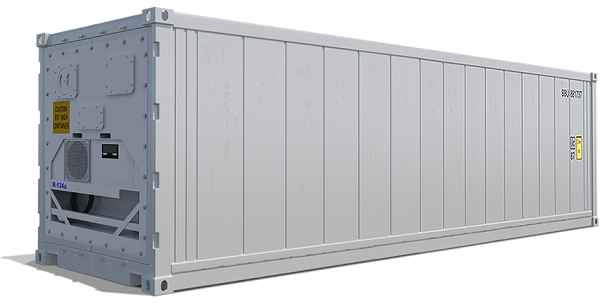
CONTAINER DIMENSIONS
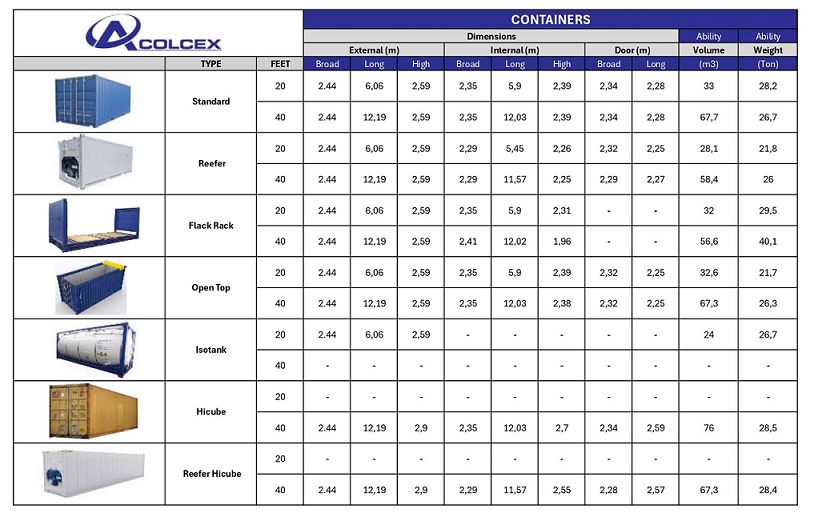
Considerations when choosing a container
- Cargo Type: Identify if the goods are perishable, bulky, hazardous, liquid, or require ventilation or temperature control.
- Size and Weight: Consider the dimensions and weight of the goods to determine if you need a standard, high cube, or specialized container.
- Transportation Routes: Some containers are better suited for certain modes of transportation, such as ocean, road or rail.
Here are some key reasons to choose the right container:
- Cargo Protection: The right container protects your goods from damage, weather conditions and possible theft during transport.
- Space Optimization: Using the right container maximizes available space, allowing you to transport more products in a single shipment.
- Regulatory Compliance: Some products require specific containers to comply with international regulations and avoid legal problems at customs.
- Cost Reduction: Choosing the right container can reduce costs associated with cargo handling, storage and transportation.
- Versatility: Different types of containers, such as refrigerated or open-top, allow a wide variety of products to be transported, from perishable foodstuffs to heavy machinery.
- Security: Specialized containers, such as those with secure locking systems, offer greater protection against unauthorized access.
- Sustainability: Reusable and durable containers help reduce environmental impact and promote sustainable logistics practices.
These reasons help highlight the importance of selecting the right container to ensure efficient and safe transportation.
